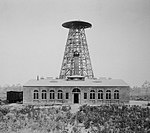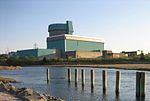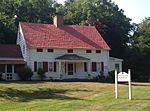Shoreham station (LIRR)
1900 establishments in New York (state)1938 disestablishments in New York (state)Former Long Island Rail Road stations in Suffolk County, New YorkNew York (state) railway station stubsRailway stations in the United States closed in 1938 ... and 1 more
Railway stations in the United States opened in 1900

Shoreham was a station on the Wading River Extension on the Port Jefferson Branch of the Long Island Rail Road. This is an abandoned station just east of the intersection of North Country Road and Randall Road, along what is now access for Long Island Power Authority power lines.
Excerpt from the Wikipedia article Shoreham station (LIRR) (License: CC BY-SA 3.0, Authors, Images).Shoreham station (LIRR)
North Shore Rail Trail,
Geographical coordinates (GPS) Address Nearby Places Show on map
Geographical coordinates (GPS)
| Latitude | Longitude |
|---|---|
| N 40.949333333333 ° | E -72.899527777778 ° |
Address
North Shore Rail Trail
North Shore Rail Trail
11786
New York, United States
Open on Google Maps







